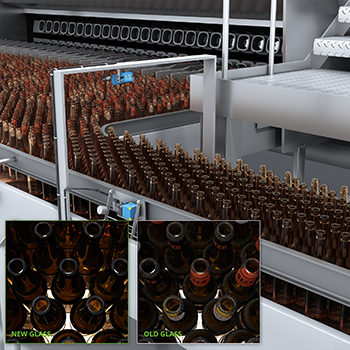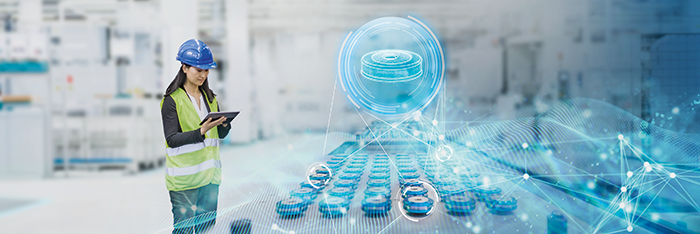Machines learn to think. Deep Learning is a machine learning technique and probably the most important future technology within the field of artificial intelligence. SICK has already taken many steps in this field and developed a wide variety of applications that offer customers additional benefits for greater productivity and flexibility.
Artificial intelligence (AI) solutions are increasingly conquering industrial production
Artificial intelligence (AI) solutions are increasingly conquering industrial production at the sensor level as well. Which sensors has Sick already equipped with AI intelligence?
Rene Klausrigler, Market Product Management "Identification/Mesuring": SICK offers a special SensorApp called "Intelligent Inspection" for this purpose. The SensorApp is based on Deep Learning, a subcategory of artificial intelligence (AI). Deep Learning-based machine vision is particularly suitable for objects with incalculable properties, such as naturally grown objects, deformed and defective objects, or objects with complex and irregular shapes. The example-based deep learning approach is intuitive and simplifies application development. The SensorApp Intelligent Inspection can be used directly on all InspectorP6xx 2D vision cameras. By combining traditional machine vision for quality inspection (Quality Inspection App) with powerful advanced deep learning, the Intelligent Inspection App opens up new possibilities for users to automate demanding inspection tasks that were previously not possible. Users can easily collect data to train the neural network and deploy the trained network directly on the sensor and without additional equipment. In addition, conventional rule-based machine vision software tools are available.
Machine vision classifications with artificial intelligence can be easily set up and executed across the entire portfolio of SICK InspectorP6xx vision sensors. The newly introduced, ultra-compact InspectorP61x is currently the smallest vision sensor with Deep Learning running directly in the device. Intelligent inspection capabilities extend to the rugged InspectorP65x with its particularly high resolution and extended field of view. In addition to the InspectorP6xx family, it is also possible to run the Intelligent Inspection App on our controllers (SIM's - Sensor Integration Machines). This is used if, for example, the object has to be viewed from several sides in the application. For this purpose we use our 2D streaming cameras of the Midi and Pico Cam series.
For which applications does Sick already offer its customers sensor-based AI assistance?
Matej Nujic, Marketing Product Specialist Industrial Vision & Systems: Most customer requests come from manufacturing or optical quality control. A sensor learns, processes the information and acquires functionality to find an adapted solution to the problem posed. Such solutions show that artificial intelligence and sensor intelligence are getting closer and closer and together they are driving Industry 4.0 forward.
Applications for which it was previously very difficult to achieve consistently stable and repeatable quality inspections can now be solved with high reliability and availability using the SICK Intelligent Inspection SensorApp. This makes even complex image processing tasks practical and affordable.
Deep learning is a subarea of artificial intelligence - can you briefly outline the technological sequence at the sensor and IT level?
Klausrigler: With the Intelligent Inspection image capture tool, users first collect sample images of their product under real production conditions. They then simply upload these to SICK's cloud-based dStudio. In a step-by-step process, they use this tool to train and evaluate a neural network that meets the requirements of the inspection task. If necessary, additional images can then be added and evaluated to further perfect the result.
In principle, deep learning increases machine behavior and thus production sections can be designed more efficiently. Which Deep Learning projects are already being implemented at Sick and which can be expected in the near future?
Nujic: With many applications of AI, we provide our customers with the key to entering a new era of sensor intelligence. This gives them the ability to solve more challenging tasks, to adapt quickly to changing conditions, to recognize patterns more easily - faster and more reliably than ever before. Valuable data is collected by our sensors and interpreted by our algorithms. Customers can focus on their resources and optimize workflows.

The InspectorP621 2D vision camera in combination with the SICK AppSpace SensorApp Intelligent Inspection enables classification of the bottle flow according to new and used glass in the infeed area of the cleaning machine. For this purpose, neural networks are trained in the cloud using sample images. The intelligent algorithm evaluates the images directly in the camera.
In this way, InspectorP621 enables automated switching between the different programs for new and used glass and thus optimized water consumption by the machine. In addition, faults in the feed area that require operator intervention can be reduced. This saves costs and increases machine availability.
Developers can create their own SensorApps in the SICK AppSpace. For which industries is the SICK AppSpace interesting and how complex is the app creation?
Klausrigler: Vision solutions based on our SICK AppSpace eco-system help our customers take an important step towards the future and Industry 4.0. With SICK AppSpace, they create completely new and adaptive solutions for automation applications in the areas of quality control, positioning, robot guidance, or track-and-trace, regardless of industry.
How much effort does it take to use your Deep Learning SensorApp and can your users expect Sick to provide support?
Nujic: The realization of a Deep Learning project is not very complex, one speaks here more or less of configuring and not of programming. Thus, a high level of vision know-how is not necessary. If the user already has experience in the field of image processing, it is not absolutely necessary for us to provide support here, but of course we also offer this service. With the help of the Gold Deep Learning Starter Package, our customers become professionals for their Deep Learning applications. Here, a SICK expert trains the customer on commissioning 2D vision sensors and teaches the possibilities of artificial intelligence. In addition to the ideal settings for the sensor and the network, there are many tips and tricks, such as preparing an optimal database for training the neural network. Then, the customer can collect data with the help of the sensor and ideally trains the neural network all by himself. This ensures an efficient use of deep learning solutions.
The interview was conducted in German language by Luzia Haunschmidt (Editor-in-chief for x-technik-AUTOMATION) and was originally published in the x-technik-AUTOMATION special edition 1/2022.
I want to stay up to date and regularly be informed about new articles!
Rene Klausrigler
Market Product Management ''Identification/Measuring''
Matej Nujic
Market Product Specialist Industrial Vision & Systems





